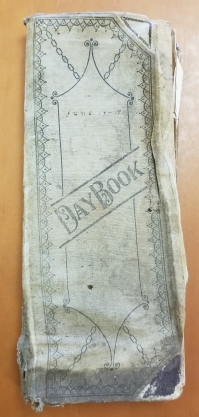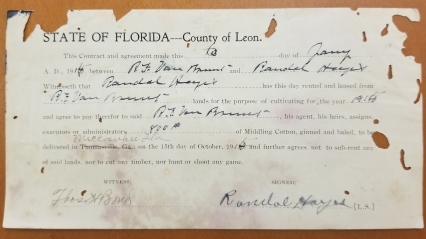
Around thirteen miles North from downtown Tallahassee is Lake Iamonia. Families such as the Van Brunts historically developed the land around Iamonia as large cotton plantations. R.F. Van Brunt was born in 1862 and from 1902 to 1911 operated a general store and the Van Brunt plantation in the area. The collection primarily comprises store account ledgers like the 1911 Day Book on the left.
At first glance these financial ledgers may not contain anything other than store balances and goods sold. However, this collection sheds light on local sharecropping. Sharecropping was an agricultural labor system that replaced slavery following the end of the Civil War. Plantation owners used this system to keep many former enslaved people bound to their plantations to maintain their crop-driven businesses.
Sharecropping contracts, like the one below found in one of the Van Brunt store ledgers contracting Randall Hayes, leased land to the sharecropper to cultivate a cash crop. At a specified date, the sharecropper had to produce the contracted quantity of which they kept a portion. 
The Van Brunt store ledgers help us understand the economics of sharecropping. The country store in Iamonia is one example of how credit networks drove sharecropping. At the beginning of the agricultural year, sharecroppers bought their seeds and supplies on credit. The store often supplied individuals for months at a time without receiving payment. Near the date on their contracts, sharecroppers paid their store account in several ways.
The entry for September 16th affirms that five individuals received a balance on their store account for labor “by hauling seed.”
While they could pay cash if they had it, sharecroppers paid their store balance down with agricultural goods as well. The entry from October 6th reveals that customers paid their store accounts down “by cotton.” Because they paid rent on farmland, and sometimes store balances, in cotton, local sharecroppers often settled their debt with the plantation owner and store during the harvest season.
Infrequent opportunities to settle accounts with plantation owners, natural disruptions, and crop failures meant that sharecropping easily became a cycle of debt that trapped African Americans on the same plantations that enslaved them or their parents.
We invite members of the FSU community and the general public to access our collections in our reading room on the first floor of Strozier Library Monday-Thursday from 10:00-6:00 and Friday from 10:00-5:30.
The 1911 Day Book and Sharecropping Contracts are also available for viewing in our digital library, DigiNole.
Click here to learn more about the Van Brunt Business Records.
Further Reading:
Paisley, Clifton. “Van Brunt’s Store, Iamonia, Florida, 1902-1911.” Florida Historical Quarterly 48 (1970): 353-367.
In the Day Book, the numbers on the right-hand side: what do they represent? Are those dollar amounts?
Seems like a lot of money for the period, but I don’t know.
Thank you,
Randy
Hi Randy, those numbers do represent dollar amounts. It was either money added to their account as payment for labor or money paid towards their debt (rent and store items) through cash or goods.
Let us know if you have any more questions!